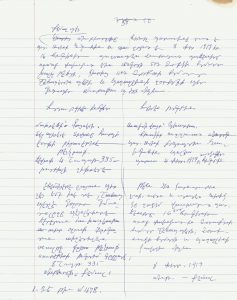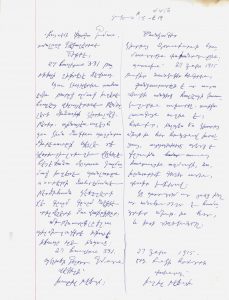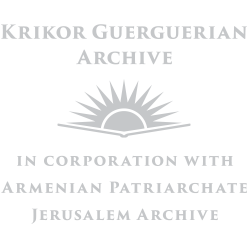The third part of the Guerguerian archive includes rich materials in the Armenian language. Most of these materials are handwritten in Western Armenian, some of them are in Grabar (Ancient Armenian). About 90 PDF files include Armenian language materials with different content. The oldest documents in this archive date back to 1830s. These are the letters and reports sent from Kyurin (Gürün, Sivas province) to the Armenian Catholic religious congregation of priests of Bzommar, in Lebanon. These letters and reports are mostly in Grabar and about the everyday life of Kyurin Armenians. This correspondence went on from 1831 until 1914. The researchers can find rich materials on ethnography, gender relations, public life, and interethnic relations of the Armenian community and specifically Catholic Armenians of Kyurin. Letters written between the 1894-1896 period are also interesting, for they provide a deeper context into the Hamidian massacres era, which occurred in the Armenian provinces of the Ottoman Empire.
 The archival materials come from the personal archive of Zaven Yeghyayan, the Armenian Patriarchate of Constantinople. They include letters and reports sent to him prior to, during, and after the Armenian genocide. An interesting element of pre-genocide materials in the archive are the reports of different Armenian settlements within the Ottoman Empire, sent to the Armenian Patriarchate during 1913 and 1914. These documents contain information about land and property issues, as well as general oppression of the Armenian millets. There are also materials and letters that warn the Patriarch about the imminent danger for the Armenian people, dating back to the end of 1914. Interestingly, Yeghyayan had received letters about the pitiful conditions of the Armenian soldiers, regarding their desecration, and their murder. He received messages before his deportation from Constantinople in 1915. One of these letters, from Urfa, details how an Armenian intellectual managed to hide from the Turkish authorities and wrote to the Patriarch about the situation of the Armenian deportees within an Urfa concentration camp, and the murder of Armenian intellectuals who were deported to Çankırı. The copies of the original letters from the Armenian Catholicos of Cilicia, Sahak Khapayan, written in 1915, have also survived in this archive. In the letters mentioned above, Khapayan describes the situation of the Armenian deportees during his voyage to Aleppo, then to Jerusalem.
The archival materials come from the personal archive of Zaven Yeghyayan, the Armenian Patriarchate of Constantinople. They include letters and reports sent to him prior to, during, and after the Armenian genocide. An interesting element of pre-genocide materials in the archive are the reports of different Armenian settlements within the Ottoman Empire, sent to the Armenian Patriarchate during 1913 and 1914. These documents contain information about land and property issues, as well as general oppression of the Armenian millets. There are also materials and letters that warn the Patriarch about the imminent danger for the Armenian people, dating back to the end of 1914. Interestingly, Yeghyayan had received letters about the pitiful conditions of the Armenian soldiers, regarding their desecration, and their murder. He received messages before his deportation from Constantinople in 1915. One of these letters, from Urfa, details how an Armenian intellectual managed to hide from the Turkish authorities and wrote to the Patriarch about the situation of the Armenian deportees within an Urfa concentration camp, and the murder of Armenian intellectuals who were deported to Çankırı. The copies of the original letters from the Armenian Catholicos of Cilicia, Sahak Khapayan, written in 1915, have also survived in this archive. In the letters mentioned above, Khapayan describes the situation of the Armenian deportees during his voyage to Aleppo, then to Jerusalem.
The most prominent part of the archive includes materials about the genocide’s aftermath. Lists and separate files from perpetrators, with their short biographies and committed crimes, can be found in the archive. In addition to these materials, there are also reports from genocide survivors that document lists of their losses as well as perpetrator names. These files were made specifically for the Court Martial.
Testimonies of survivors, in addition to those from Muslim bystanders, represent an integral part of the archive. Armenian refugees in Rodosto (Takirdağ), for example, sent their testimonies to the Patriarch. Amongst them are letters from Armenians who survived the Izmir catastrophe in September 1922.
The archive is especially rich in reports and letters from Cilicia, dating back to 1919-1922. Mihran Tamatian was regularly reporting to the Patriarch about the situation in the region, the milli movement, the conditions of Armenian refugees and orphans, the negotiations with Colonel Bremond’s administration in Cilicia, the Armenian Legion, etc.
 The archive contains important information regarding the Armenian Catholic clergy. It refers to many Armenian churches and chapels, across myriad villages, with their respective clergies, their activities and, in most cases how they were killed during the genocide. There are original letters from Avedis Aharonian and from the other representatives of the First Armenian Republic. There is also a detailed description of the Armenian delegations’ activities in Paris regarding the Peace Conference.
The archive contains important information regarding the Armenian Catholic clergy. It refers to many Armenian churches and chapels, across myriad villages, with their respective clergies, their activities and, in most cases how they were killed during the genocide. There are original letters from Avedis Aharonian and from the other representatives of the First Armenian Republic. There is also a detailed description of the Armenian delegations’ activities in Paris regarding the Peace Conference.
Concluding the short description of the Third Guerguerian archive, we can say that this part of it is the most important one because it mainly consists of original documents, which are partly unpublished.
For more information on Armenian language materials please see: Armenian materials of the Guerguerian archive
